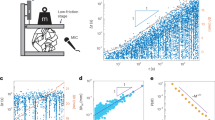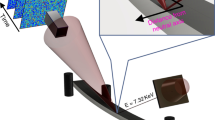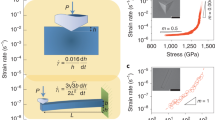Abstract
Many systems in nature—glasses1,2,3,4,5,6,7,8,9,10,11, interfaces12 and fractures13 being some examples—cannot equilibrate with their environment, which gives rise to novel and surprising behaviour such as memory effects, ageing and nonlinear dynamics. Unlike their equilibrated counterparts, the dynamics of out-of-equilibrium systems is generally too complex to be captured by simple macroscopic laws1. Here we investigate a system that straddles the boundary between glass and crystal: a Bragg glass14,15, formed by vortices in a superconductor. We find that the response to an applied force evolves according to a stretched exponential, with the exponent reflecting the deviation from equilibrium. After the force is removed, the system ages with time and its subsequent response time scales linearly with its ‘age’ (simple ageing), meaning that older systems are slower than younger ones. We show that simple ageing can occur naturally in the presence of sufficient quenched disorder. Moreover, the hierarchical distribution of timescales, arising when chunks of loose vortices cannot move before trapped ones become dislodged, leads to a stretched-exponential response.
Similar content being viewed by others
Main
Glassy states of matter abound with seeming contradictions: macroscopically they are rigid like crystals, but microscopically their structure is closer to that of liquids. At the same time, their response to external drives is unlike that of either crystals or liquids, showing metastability, hysteresis and nonlinear dynamics1. In recent years the glass family has expanded to include systems that can be modelled by elastic manifolds in random potentials, such as vortices in superconductors14,15,16,17,18,19,20,21, domain walls12 or two-dimensional electron layers5,6. When the random potential is weak these systems are expected to form a marginal glassy state, a ‘Bragg glass’, which is topologically ordered like a perfect crystal, but unlike crystals has no long-range spatial order14,15. An intriguing and enduring puzzle associated with this phase is the dynamics at the onset of motion: does it move as a rigid object or break up into pieces; does it crystallize at high velocities or retain its glassy nature22,23,24,25?
To probe the dynamics, we focused on vortex states in single crystals of 2H-NbSe2 because in this material quenched disorder can be sufficiently weak to allow the formation of a Bragg glass. The vortex states were prepared by field cooling the sample below the superconducting transition in a field of 0.2 T and temperatures down to 4.2 K (see the Supplementary Information). The results reported here were obtained on a sample of size 4.4×0.8×0.006 mm3 and transition temperature 7.2 K (see the Supplementary Information). At low temperatures (T<5.7 K), where the Bragg glass is expected, the response of a freshly prepared field-cooled lattice to a current pulse was previously19 found to fit stretched-exponential, or Kohlrausch–Williams–Watts (KWW) time dependence10,11, spanning three decades in time: V (t)=V1{1−exp(−[(t−t0)/τ]β)}. Here V1 is the saturation voltage, t0 the delay time before a measurable voltage appears, τ the rise time and β∼0.6. The experimental protocol consists of applying a first current pulse of amplitude I1 followed by a second pulse I2, during which the evolution of the voltage is recorded (Fig. 1b, inset). The pulses are separated by a waiting time tw without current. Remarkably, the response is significantly slower during the second pulse than during the first pulse and its evolution depends not only on the elapsed time from the onset of I2, as is the case in ergodic systems, but also on tw, so V (t)=V (t,tw). This behaviour, also known as ageing, is one of the hallmarks of glassy dynamics1,2,3,4,5,6,7,8. The response curves for I2=I1 and several values of tw are presented in Fig. 1a. When the same data are re-plotted against the scaled time t/tw (Fig. 1b), all the curves collapse without adjustable parameters onto a master curve,

The scaling constant, γ, is independent of tw, leading to a special and rare form of ageing, V (t,tw)=V (t/tw), also known as simple or full ageing6,7,8. Simple ageing is remarkably robust in this system, extending over almost five decades in reduced time and holding to the longest measurement times ∼2tw. For T<5.5 K and at low saturation voltages, V <5 μV, the exponent β is independent of tw and temperature. Its value, β∼0.24, obtained for V1=1.0 μV, decreases slightly with increasing V1 (Fig. 1c). Simple ageing continues to hold at higher drives, but the range of the KWW fit is reduced. We find that the KWW function fits the data over a wider range than other simple choices. For example, a logarithmic fit, also commonly used6, is indistinguishable from KWW for t<0.1tw, but becomes worse at longer times. We note that for the second pulse β≤0.24 is significantly lower than in the first-pulse case, where β∼0.6. As shown below, this provides an important clue to the glassy dynamics of moving vortex states.
a, Response during the second pulse following a first pulse of duration t1=512 s and amplitude I1=I2=5.36 mA. The waiting times tw=4 s, 8 s, 16 s, 32 s, 64 s, 128 s, 256 s, 512 s, 1,024 s and 2,048 s increase along the arrow. b, Scaled second-pulse response versus scaled time. A linear fit gives β (slope) and γ from the intercept, −log(1−V/V1)=1. The experimental set-up is shown in the inset. c, Temperature dependence of β for first pulse and second pulse (open and solid symbols). Pulse amplitudes were adjusted to give the same saturation voltage at all temperatures.
To study the case I1≠I2,I1 was varied while keeping I2 constant. The response is a sensitive function of I1: it is slowest for I1=I2 and becomes faster whenever the two levels are not equal (Fig. 2a). In other words, the system retains an imprint of I1, which can be retrieved later in the form of a maximal slow-down during I2. For t>0.1 s, the response during I2 fits a generalized form of equation (1):

Here V2 is the second-pulse saturation voltage and f=f(V1/V2) is a ‘memory function’. As shown in Fig. 2b, for each V2 there exists a unique value f that collapses the response for all V1 onto one curve. We plot the memory function obtained by this procedure in Fig. 2c. Although the asymptotic response (t>0.1 s) obeys equation (2), this form is not valid at short times (Fig. 2d).
a, Time evolution of the second pulse for V2=1.3 μV. b, Same data as in a, showing that there exists a value, f(V1/V2), for which the scaled data, −log[(1−V/V2)/f], collapse onto a master curve. c, The memory function, f (V1/V2), obtained as described in b. The highlighted area encloses data taken in the Bragg-glass regime, where memory is strongest. For T>5.7 K f flattens out, signalling a more feeble memory. d, Response in the first 0.3 ms of the second pulse, for tw=240 s,I2=9.1 mA, showing strong first-pulse memory.
We studied another limit, tw=0, by applying ‘step pulses’ where the first pulse I1 was directly switched after a time t1 to the second pulse I2. If we do not allow the response to saturate during the first pulse, the second-pulse response is identical to that of a single pulse of amplitude I2 with a shifted time origin: V [t−(t1−δt)]. The shift δt is linear in t1 (Fig. 3a, inset), a behaviour that provides an additional clue to the mechanism underlying the glassy dynamics in this system.
KWW relaxation is far more common than the ‘conventional’ exponential form (β=1). It occurs in complex systems where the dynamics is governed by a statistical distribution of relaxation times together with constraints that restrict the path towards steady state to a hierarchical sequence of steps9,10,11. The hierarchy arises if certain segments (here chunks of vortices) cannot start moving until the ones in front of them are dislodged. A model of hierarchically constrained dynamics that leads to a KWW response with β=1/(1+μ0log 2), where μ0 is the number of degrees of freedom involved in initiating the process of relaxation, has been proposed9. Thus different values of β imply qualitative differences in the initial conditions, with smaller β corresponding to more entangled states, which require more steps to reach steady state. The exponents, β∼0.6 and β∼0.2, imply that the corresponding initial states for the first pulse and second pulse are inherently different. For the former, μ0∼1 implies that the initial field-cooled state is readily set in motion, whereas for the latter, μ0∼10 indicates that the moving state (the second pulse is applied after the system experienced motion) is more entangled. This striking difference, together with the fact that the initial value, β∼0.6, cannot be recovered without warming up the sample, suggests that the structure of the field-cooled state is altered irreversibly after the onset of motion. We propose that this is due to the introduction of dislocations when, owing to pinning-potential inhomogeneities, some chunks of vortices start moving before others. As was shown in numerical simulations of driven two-dimensional interacting systems26, the dislocations minimize their energy by forming grain boundaries and by aligning their Burgers vectors along the direction of motion. When the drive is suddenly removed they drift to restore the original state. However, if annealing timescales are much longer than experimental times, the grain boundaries coarsen, forming a more entangled network of dislocations, resulting in a lower value of β.
It is generally accepted that the energy landscape of a finite disordered system has many local minima corresponding to metastable configurations surrounded by high energy barriers that can trap the system8. The trapping time in a metastable state increases with trap depth. In this context we can model the dynamics of the vortex system by mapping each state onto a point in configuration space and representing the evolution between two states by a connecting trajectory consisting of a sequence of trapped states. Thus, during the first pulse the system evolves from the field-cooled state to the moving vortex state along a connecting trajectory as shown in Fig. 4. During tw when the drive is absent, the system drifts away from the moving-state point towards a lower-energy relaxed state, where the grain boundaries have coarsened. Both simple ageing and the response to a step pulse can be described within this model.
Configuration-space representation of vortex states and connecting trajectories. During the first pulse the system evolves along the FC–MS (field-cooled–moving-state) trajectory, which is independent of driving force. In between pulses the system drifts towards the relaxed state (RS). During the second pulse, it is driven back to the moving state.
The key point for simple ageing is that the deepest traps encountered during tw must have trapping times τt∼tw. This was shown to be the case8 for trapping times that have exponential or power-law distributions, provided the maximum trapping time is much shorter than tw. Therefore, during the subsequent second pulse, while the system is driven back towards the moving state and traversing the same deepest trap, the trapping time should again be ∼tw, provided the drive does not significantly change the energy landscape. In other words, tw selects a timescale (out of a broad distribution) that becomes the characteristic scale for subsequent response events. This naturally gives rise to simple ageing. However, in spite of its ‘simplicity’, simple ageing is rare and was only recently observed in a Coulomb glass5,6 and in a spin glass7. It is noteworthy that ageing may disappear altogether if the distribution of τt is not continuous or if it is truncated. For example, in very disordered samples where τt≫tw, the system remains trapped close to the moving state long after the drive is removed. This is the case for vortex states in Fe-doped 2H-NbSe2, where no ageing was observed for tw≤24 h (ref. 17). At the other extreme lies the case of clean samples, where ageing is not seen either because there is a unique equilibrium state (no trapping) or because τt is much shorter than the measurement times. This implies that there is a critical amount of disorder needed to observe ageing (see the Supplementary Information).
The response to step pulses imposes two additional constraints. (1) For a given first-pulse amplitude I, the configuration space ‘speed’, v(I), along the FC–MS trajectory is constant. (2) v(I) increases with increasing I. Thus during the first pulse the system evolves at an average speed v1=v(I1) such that at time t1 it reaches an intermediate point P along FC–MS. During the second pulse the remainder of the trajectory is traversed at a higher speed v2=v(I2). Had the entire FC–MS trajectory been traversed at speed v2, then P would have been reached at a time δt=t1(v1/v2) after the pulse onset. Therefore, the response during the second pulse, V ′(t−(t1−δt)), is identical to that for a single pulse of amplitude I2 applied δt before t1.
The experiments described here demonstrate that in the presence of quenched disorder the response of a driven vortex system to a current pulse can be described by KWW time dependence, with the exponent reflecting the deviation of the initial state from equilibrium. It is shown that there exists a range of strengths of the quenched disorder for which the system can show ageing and that simple ageing arises naturally in samples with a continuous distribution of trapping times whose range is much wider than that of experimental waiting times.
References
Cugliandolo, L. F. in Dynamics of Glassy Systems, Lecture Notes in Slow Relaxation and Non Equilibrium Dynamics in Condensed Matter, Les Houches Session 77 July 2002 (eds Barrat, J.-L., Dalibard, J., Kurchan, J. & Feigel’man, M. V.) Preprint at <http://arxiv.org/abs/cond-mat/0210312>.
Struik, L. C. E. Physical Aging in Amorphous Polymers and Other Materials (Elsevier, Amsterdam, 1978).
Lundgren, L., Svedlindh, P., Nordblad, P. & Beckman, O. Dynamics of the relaxation-time spectrum in a CuMn spin-glass. Phys. Rev. Lett. 51, 911–914 (1983).
Lederman, M., Orbach, R., Hammann, J. M., Ocio, M. & Vincent, E. Dynamics in spin glasses. Phys. Rev. B 44, 7403–7412 (1991).
Vaknin, A. & Ovadyahu, Z. Aging effects in an Anderson insulator. Phys. Rev. Lett. 84, 3402–3405 (2000).
Orlyanchik, V. & Ovadyahu, Z. Stress aging in the electron glass. Phys. Rev. Lett. 92, 066801 (2004).
Rodriguez, G. F., Kenning, G. G. & Orbach, R. Full aging in spin glasses. Phys. Rev. Lett. 91, 037203 (2003).
Bouchaud, J. P. Weak ergodicity breaking and aging in disordered systems. J. Phys. (Paris) I 2, 1705–1713 (1992).
Palmer, R. G., Stein, D. L., Abrahams, E. & Anderson, P. W. Models of hierarchically constrained dynamics for glassy relaxation. Phys. Rev. Lett. 53, 958–961 (1984).
Kohlrausch, R. Theorie des elektrischen rückstandes in der leidener flasche. Ann. Phys. Chem. (Leipzig) 91, 179–214 (1874).
Williams, G. & Watts, D. C. Non-symmetrical dielectric relaxation behavior arising from a simple empirical decay function. Trans. Faraday Soc. 66, 80–85 (1970).
Repain, V. et al. Creep motion of a magnetic wall: Avalanche size divergence. Europhys. Lett. 68, 460–466 (2004).
Måløy, K. J. & Schmittbuhl, J. Dynamical event during slow crack propagation. Phys. Rev. Lett. 87, 105502 (2001).
Giamarchi, T. & LeDoussal, P. Elastic theory of flux lattices in the presence of weak disorder. Phys. Rev. B 52, 1242–1245 (1995).
Klein, T. et al. Bragg glass phase in the vortex lattice of a type II superconductor. Nature 413, 404–406 (2001).
Henderson, W., Andrei, E. Y., Higgins, M. J. & Bhattacharya, S. Metastability and glassy behavior of a driven flux-line lattice. Phys. Rev. Lett. 77, 2077–2080 (1996).
Xiao, Z. L., Andrei, E. Y. & Higgins, M. J. Flow induced organization and memory of a vortex lattice. Phys. Rev. Lett. 83, 1664–1667 (1999).
Valenzuela, S. O. & Bekeris, V. Plasticity and memory effects in the vortex solid phase of twinned YBa2Cu3O7 single crystals. Phys. Rev. Lett. 84, 4200–4203 (2000).
Li, G., Andrei, E. Y., Xiao, Z. L., Shuk, P. & Greenblatt, M. Glassy dynamics in a moving vortex lattice. J. Phys. IV 131, 101–107 (2005).
Bustingorry, S., Cugliandolo, L. F. & Domínguez, D. Out-of-equilibrium dynamics of the vortex glass in superconductors. Phys. Rev. Lett. 96, 027001 (2006).
Li, G., Andrei, E. Y., Xiao, Z. L., Shuk, P. & Greenblatt, M. Onset of motion and dynamic reordering of a vortex lattice. Phys. Rev. Lett. 96, 017009 (2006).
Shi, A. C. & Berlinsky, A. J. Pinning and I–V characteristics of a two-dimensional defective flux-line lattice. Phys. Rev. Lett. 67, 1926–1929 (1991).
Koshelev, A. E. & Vinokur, V. M. Dynamic melting of the vortex lattice. Phys. Rev. Lett. 73, 3580–3583 (1994).
Balents, L., Marchetti, M. C. & Radzihovsky, L. Nonequilibrium steady states of driven periodic media. Phys. Rev. B 57, 7705–7739 (1998).
LeDoussal, P. & Giamarchi, T. Moving glass theory of driven lattices with disorder. Phys. Rev. B 57, 11356–11403 (1998).
Reichhardt, C. & Olson Reichhardt, C. J. Coarsening of topological defects in oscillating systems with quenched disorder. Phys. Rev. E 73, 046122 (2006).
Acknowledgements
We wish to thank E. Abrahams, T. Giamarchi, E. Lebanon, M. Markus, C. Olson Reichhardt, A. Rosch and B. Rosenstein for useful discussions. We thank I. Skachko for technical support. The work was supported by NSF-DMR-0456473 and by DOE DE-FG02-99ER45742.
Author information
Authors and Affiliations
Contributions
X.D. and G.L. carried out the experiments and E.Y.A., X.D. and G.L. participated in the analysis. X.D. and G.L. participated in the experimental set-up and the project was conceived by E.Y.A. The crystals were supplied by M.G. and P.S.
Corresponding author
Ethics declarations
Competing interests
The authors declare no competing financial interests.
Supplementary information
Rights and permissions
About this article
Cite this article
Du, X., Li, G., Andrei, E. et al. Ageing memory and glassiness of a driven vortex system. Nature Phys 3, 111–114 (2007). https://doi.org/10.1038/nphys512
Received:
Accepted:
Published:
Issue Date:
DOI: https://doi.org/10.1038/nphys512
This article is cited by
-
Jamming, fragility and pinning phenomena in superconducting vortex systems
Scientific Reports (2020)
-
Hot halos and galactic glasses (carbonado)
Journal of High Energy Physics (2012)
-
Flux Dynamics and Time Dependent Effects in Superconducting MgB2
Journal of Superconductivity and Novel Magnetism (2012)







